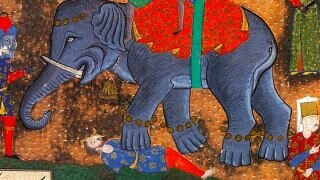Execution by Elephant: History’s Most Jumbo Way to Die

There are no humane ways of executing people, but there are plenty of ways that at least vaguely nod toward it — ending a life in as efficient and pain-free a way as possible. One element that doesn’t show up in any of those? Telling an elephant to stomp on someone’s head.
Execution has often been a way for rulers to not only kill dissenters, but to do so in a way that really makes it clear nobody else should fuck with them. It’s not just about punishing or ridding yourself of the person involved, but a big-ass “this is what you get” signal to the rest of the world.
And what could be more big-ass than using an elephant to do it? Asses don’t come much bigger, after all.
Don't Miss
The earliest record of punishment by pachyderm comes from ancient Macedonia (now around Greece) around 300 B.C. Perdiccas was a general who served under Alexander the Great. When Alexander died, Perdiccas became head of the Macedonian army and pulled the strings of Alexander’s heir, Philip III, who had, uh, learning difficulties. One of the ways Perdiccas swung his dick about was to have 300 or so mutineers crushed to death by elephants in front of as many people as possible. It didn’t entirely work as a deterrent, as Perdiccas ended his days by being killed by mutineers from his own army following a failed campaign in Egypt.
There was also a brief period in Africa around 240 B.C. in which the Carthiginian army — hailing from what is now Tunisia — went through a phase of having Numidian prisoners (from around what is now Algeria) trampled to death. The winner of this conflict, known as the Truceless War, was Hamilcar Barca, whose son, Hannibal — Vin Diesel’s favorite historical figure — was famously a huge fan of elephants.
Meanwhile, an ancient Indian legal text dating from around 200 B.C., the Mānava-Dharmaśāstra, suggests being crushed by an elephant as an appropriate sentence for theft, tax evasion or rebellion against the king. The early medieval period featured a reasonable amount of betusked capital punishment as well — the Lakhmid Empire, based around modern-day Iraq, came to an end beneath enormous elephantine feet. King Al-Nu’mān III ibn al-Mundhir was executed by his former ally, Khosrow II, following a mysterious dispute about either a horse, Nu’man’s daughter or the prior execution of a mutual acquaintance. Whatever their beef was, it ended under an elephant.
All that said, most historical accounts of elephant executions (elexecutions?) come from the Indian subcontinent and the area surrounding it. Most were straightforward stompings, but some involved the innovation of attaching blades to the animals. A first-person account from around 1330 in Delhi details spikes being strapped to the elephants’ feet, while a 17th-century account from Sri Lanka describes three-pronged spikes being secured to the elephants to slice their victims limb from limb. There are tales from the same time of elephants being trained to hold a prisoner down with one massive foot, and then using their trunks to pull off the prisoner’s arms and legs.
A Scottish explorer named Alexander Hamilton — nothing to do with Broadway’s favorite bastard orphan son of a whore — witnessed an execution in Siam (now Thailand) in the 1700s, writing, “The condemned Person is made fast to a Stake driven into the Ground for the Purpose, and the Elephant is brought to view him, and goes twice or thrice round him, and when the Elephant’s Keeper speaks to the monstrous Executioner, he twines his Trunk round the Person and Stake, and pulling the Stake from the Ground with great Violence, tosses the Man and the Stake into the Air, and in coming down, receives him on his Teeth, and making him off again, puts one of his fore Feet on the Carcase, and squeezes it flat.”
Cavalier attitude toward capitalization aside — and in the original version all the Ss look like Fs, it’f impoffible to read the ftupid thing, fuck’f fake, learn to fpell, you filly baftard — it’s all pretty grim.
During the 16th to 19th centuries, the Mughal Empire in present-day India regularly featured public executions. Some were hyper-efficient splattings while others were more drawn out, with the elephants’ trainers, or mahouts, getting the creatures to play with the condemned prisoners first, rolling them around and making the whole thing more torturous. A 19th-century account from Gujarat — published in a collection of ready-made anecdotes, The Percy Anecdotes, sold as a shortcut to appear urbane, well-read and well-traveled — describes another method, in which a prisoner was dragged along the ground attached to one of an elephant’s legs, all of his limbs dislocating and breaking, before finally having his head crushed. Another, from Sri Lanka again, details an elephant being commanded to systematically and repeatedly stamp on every limb of the condemned before delivering the final crushing blow.
Thankfully, by the 20th century, execution by elephant was over. It was brought to an end by a number of things — British imperial forces saw the practice as barbaric (though casting no such judgment on their own actions, of course), and advances in technology saw elephants used less and less for militaristic purposes, replaced by artillery and armoured vehicles.
While nobody could in good conscience call for its revival — and it was undeniably horrific — modern execution methods are just as brutal, inhumane and unethical, and to add insult to (fatal) injury, you don’t even get to meet an elephant.